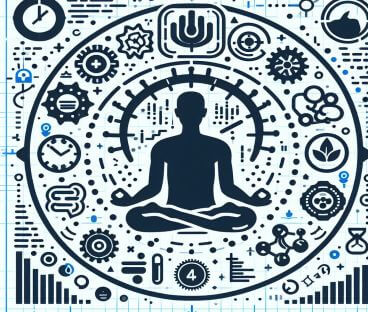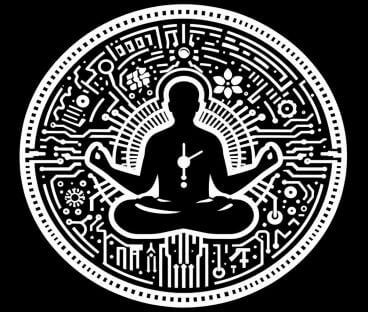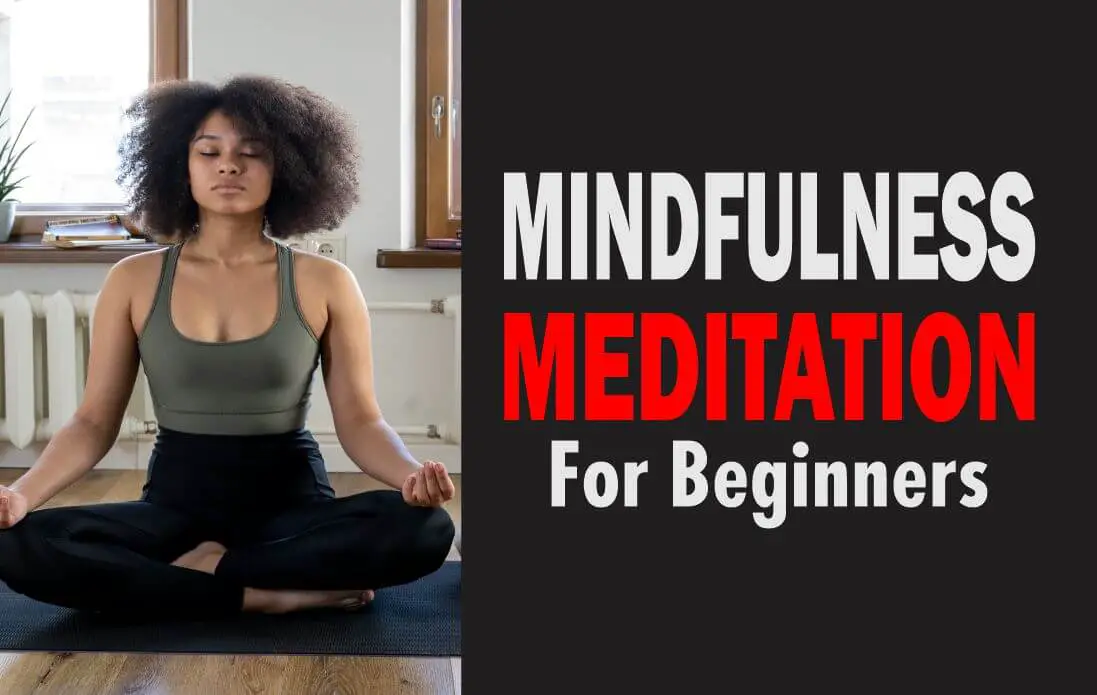Last updated on March 1st, 2024 at 07:42 pm
Mindfulness meditation techniques for beginners are a good start for new people who want to explore the world of mindfulness for inner peace.
Mindfulness meditation helps reduce stress and improve focus by paying attention to the present moment without judgment.
It involves focusing on breath, sensations, and thoughts to quiet the mind and increase self-awareness.
Beginners can start in a quiet space with just a few minutes daily.
This guide explores the benefits, techniques, and establishing a practice to help you straighten your life.
By approaching with an open mind, you can achieve mental clarity and inner peace through mindfulness meditation.
Related: Mindfulness Techniques For Managing Chronic Pain
Table of Contents
- Getting Started with Mindfulness Meditation Techniques for Beginners
- Breath Awareness Meditation for Beginners
- Body Scan Meditation
- Loving-kindness Meditation
- Overcoming Common Challenges in Mindfulness Meditation for Beginners
- Incorporating Mindfulness into Daily Life
- Resources for Further Exploration
- Frequently Asked Questions
- Conclusion
Getting Started with Mindfulness Meditation Techniques for Beginners

Here are tips to get the beginner started:
1. Creating a Peaceful Environment
Before diving into mindfulness meditation for beginners, it’s crucial to establish a serene and distraction-free environment.
Find a quiet space where you can retreat from external disturbances.
Consider dimming the lights or lighting a candle to create a soothing ambiance.
You may also want to minimize visual clutter and surround yourself with objects that evoke a sense of tranquility, such as plants or inspiring artwork.
By intentionally curating your environment, you set the stage for a more focused and immersive meditation experience.

Related: Mindfulness Activities Every Adult Should Master
2. Finding a Comfortable Sitting Position
A comfortable sitting position is key to maintaining physical ease and mental focus during meditation.
Start by finding a chair or cushion that supports good posture. Sit with your spine upright but not rigid, allowing for a natural curve in your lower back.
Rest your hands on your thighs or place them gently in your lap. If sitting cross-legged on the floor is comfortable for you, feel free to explore that option as well.
The goal is to find a position that promotes alertness and relaxation simultaneously, enabling you to remain still and attentive throughout your meditation practice.
Related: Understanding Sensory Intelligence
3. Setting Aside Dedicated Time for Meditation

To establish a consistent meditation habit, allocate dedicated time each day.
Whether it’s five minutes or half an hour, choose a time that suits you.
Consider adding meditation to your morning or evening routine for a positive impact on your day. Commit to your schedule for best results.
Related: Life Mastery and How to Attain It
Breath Awareness Meditation for Beginners
If you’re new to meditation, breath awareness meditation is a great place to start.
This technique involves focusing your attention on your breath, which can help you quiet your mind, reduce stress, and improve your overall well-being.
This ancient technique allows you to harness the power of your breath to cultivate mindfulness, find inner calm, and embark on a journey of self-discovery.
In this section, we will explain the breath awareness technique and provide a step-by-step guide for beginners.
What is the Breath Awareness Technique?

Breath awareness meditation is a simple yet profound practice that centers your attention on the natural rhythm of your breath.
By focusing your mind on inhalation and exhalation, you cultivate present-moment awareness and tap into the infinite potential of the present.
This technique serves as an anchor, gently guiding your mind back to the present whenever it wanders.
Related: How Can Mindfulness Help In The Workplace?
Step-by-Step Guide for Beginners
1. Finding a Focus Point
Start by finding a comfortable position, whether sitting on a cushion or a chair, with your spine upright yet relaxed.
Shut your eyes and focus your attention on your breath.
Choose a focal point, such as the sensation of the breath at the nostrils or the gentle rise and fall of your abdomen.
This will be your anchor throughout the practice.
2. Observing the Breath
Shift your focus entirely to your chosen point of focus and observe the breath as it naturally flows in and out of your body.
Notice the sensations, temperature, and movements associated with each breath.
Be fully present, allowing the breath to be your guide and embracing the unfolding moments with curiosity and acceptance.
3. Returning to the Breath When the Mind Wanders
It’s natural for the mind to wander during meditation.
When you become aware that your mind has drifted away, gently acknowledge the thoughts or distractions without judgment.
Then, with kindness and patience, bring your attention back to the breath, using it as an anchor to ground yourself in the present.
Each return to the breath is an opportunity for growth and deepening your practice.
Tips for Maintaining Focus during Breath Awareness Meditation
Cultivate a Gentle Mindset: Approach meditation with compassion. Let go of expectations and judgments. Accept wandering thoughts, gently guiding focus back to the breath.
Set Realistic Goals: Begin with short sessions, gradually increasing duration. Maintain focus and prevent overwhelm by progressing at a comfortable pace.
Use Guided Meditations: Access guided meditation recordings or apps for support. Receive cues and reminders for breath awareness, enhancing your practice’s effectiveness.
Embrace Regular Practice: Allocate daily time for meditation. Consistent practice builds focus and yields benefits. Make it a habit to strengthen your skills and experience growth.
Related: Understanding Psychic Abilities
Body Scan Meditation

The practice of body scan meditation offers a path to reconnect with yourself and cultivate a sense of presence.
The following are ways to achieve those:
Body Scan Technique
Body scan meditation is a practice that involves systematically directing your attention to different parts of your body, observing physical sensations, and cultivating a deep sense of awareness.
It allows you to become fully present in your body, honouring its wisdom and nurturing a gentle curiosity towards its sensations.
Step-by-Step Guide for Beginners
1. Relaxing the Body
Find a comfortable position, either lying down or sitting upright. Shut your eyes take a few deep breaths and immerse yourself in the present moment.
Allow your body to relax, releasing any tension or tightness you may be holding.
2. Scanning from Head to Toe
Begin by directing your attention to the top of your head.
Slowly and methodically move your focus down through each part of your body, such as the forehead, eyes, cheeks, neck, shoulders, arms, torso, hips, legs, and feet.
Take your time with each area, gently exploring the sensations you encounter.
3. Observing Physical Sensations
As you scan each body part, pay attention to the physical sensations that arise.
Notice any warmth, coolness, tingling, pulsation, or areas of tension.
Allow yourself to be fully present with the sensations, observing them without judgment or the need to change anything.
4. Cultivating a Non-judgmental Attitude
Throughout the practice, cultivate a sense of non-judgment and acceptance.
Acknowledge whatever sensations arise, whether they are pleasant, uncomfortable, or neutral.
Embrace them as part of your unique experience at this moment, letting go of any desire for them to be different.
Benefits of Body Scan Meditation for Beginners
Body scan meditation offers numerous benefits, particularly for beginners which include the following:
Deepened Mind-body Connection: Direct attention to body parts heightens awareness of sensations, deepening the connection with the body’s wisdom and encouraging mindfulness.
Stress and Tension Reduction: Body scan meditation releases tension, promoting relaxation and reducing stress. Identify and release areas of tension for overall well-being.
Improved Self-awareness: Observing sensations without judgment increases understanding of body’s needs. Enhance self-care and health by developing greater self-awareness.
Enhanced Present-moment Awareness: Body scan cultivates present-moment awareness. Focusing on each body part trains the mind to stay in the present, reducing past-future distractions.
Related: The Power Of Mindfulness: How To Improve Your Mental Health Today
Loving-kindness Meditation

Loving-kindness meditation is a practice that taps into the wellspring of love and kindness within us, radiating it outwards to ourselves and all beings.
Let’s take a look:
What is Loving-Kindness Meditation?
Loving-kindness meditation, also known as metta meditation, is a practice that centers around generating feelings of love, kindness, and compassion.
It involves directing well-wishes and positive intentions towards oneself, loved ones, and ultimately all beings.
By cultivating these qualities, we can cultivate a deep sense of connection, empathy, and goodwill.
Step-by-Step Guide for Beginners
1. Cultivating Feelings of Love and Kindness towards Oneself
Find a comfortable position, close your eyes, and take a few deep breaths to settle into the present moment. Begin by directing your attention towards yourself.
Silently repeat phrases or affirmations such as, “May I be happy, may I be healthy, may I be safe, may I live with ease.”
As you recite these phrases, imagine sending genuine love and kindness to yourself, embracing yourself with compassion and acceptance.
2. Extending Love and Kindness to Loved Ones
Shift your focus to someone you deeply care about – a loved one, friend, or family member.
Picture them in your mind and silently offer them well-wishes. Repeat phrases such as, “May you be happy, may you be healthy, may you be safe, may you live with ease.”
Feel the warmth of love and kindness emanating from your heart towards them, envisioning their happiness and well-being.
3. Sending Love and Kindness to All Beings
Now, expand your circle of love and kindness to encompass all beings.
Imagine a vast ocean of humanity, with each person interconnected and deserving of love and compassion.
Repeat phrases such as, “May all beings be happy, may all beings be healthy, may all beings be safe, may all beings live with ease.”
Visualize your love and kindness reaching every corner of the world, touching the hearts of all living beings.
The Importance of Self-compassion in Loving-kindness Meditation
Self-compassion is a fundamental aspect of loving-kindness meditation. It serves as the foundation for extending compassion to others.
- When you cultivate love and kindness towards yourself, you nurture your well-being and become better equipped to offer genuine care to those around you.
- Self-compassion allows you to acknowledge your suffering, embrace your imperfections, and foster a deeper sense of self-acceptance and empathy.
- Practicing loving-kindness meditation with a focus on self-compassion has several benefits.
- It helps alleviate self-criticism, reduces stress, enhances emotional resilience, and improves overall well-being.
- By extending kindness and compassion to ourselves, we create a positive ripple effect that extends to our relationships, communities, and the world.
Related: What Are The Seven Pillars Of Mindfulness?
Overcoming Common Challenges in Mindfulness Meditation for Beginners

Embarking on the path of mindfulness meditation can be an enriching and transformative experience.
However, it is not uncommon for beginners to encounter challenges along the way.
The good news is that these challenges are natural and can be overcome with the right mindset and strategies.
In this section, we will explore three common hurdles that beginners often face in their mindfulness meditation practice and provide practical tips to overcome them.
Related: Mindfulness Techniques For Better Sleep And Relaxation
1. Dealing with a Wandering Mind
One of the most common challenges in mindfulness meditation is dealing with a wandering mind.
It’s natural for thoughts to arise and pull our attention away from the present moment.
However, the essence of mindfulness meditation lies in gently guiding our attention back to the present.
Here are a few strategies to help you overcome a wandering mind:
- Awareness and Acceptance: Recognize that having a wandering mind is part of the human experience. Instead of getting frustrated or judging yourself, simply observe the thoughts as they arise and let them go without getting attached to them.
- Anchoring the Mind: Use an anchor, such as your breath or a specific sensation in your body, to bring your attention back to the present moment whenever you notice your mind wandering. This anchor serves as a point of focus, grounding you in the here and now.
- Labeling Thoughts: When a thought arises, mentally label it as “thinking” or “thought” without getting caught up in its content. This labeling technique helps create distance from the thought and allows you to let it go more easily.
2. Addressing Physical Discomfort
Another challenge that beginners often face in mindfulness meditation is physical discomfort.
Sitting for an extended period can lead to sensations of stiffness, pain, or restlessness.
Here are strategies to address physical discomfort:
- Mindful Movement: Incorporate gentle stretches or mindful movement practices before or after your meditation session. This helps relieve tension, improve circulation, and prepare your body for sitting.
- Proper Posture: Pay attention to your posture during meditation. Sit with a straight back, aligning your head, neck, and spine. Use a cushion or a supportive chair to maintain a comfortable yet alert posture.
- Mindful Awareness of Sensations: Instead of resisting or trying to change physical discomfort, bring a sense of gentle curiosity and non-judgmental awareness to the sensations. Observe the discomfort as a passing phenomenon without getting caught up in the stories or judgments associated with it.
3. Patience and Persistence in the Practice
Mindfulness meditation is a skill that develops over time with patience and persistence.
It’s essential to approach your practice with a gentle and compassionate attitude.
Here are some tips to cultivate patience and persistence:
- Set Realistic Expectations: Understand that progress in mindfulness meditation is gradual and non-linear. Avoid putting pressure on yourself to achieve specific outcomes. Instead, focus on the process and the present moment experience.
- Consistency is Key: Establish a consistent routine for meditation. Even short daily sessions can be more beneficial than sporadic longer sessions. Set aside dedicated time each day to nurture your practice.
- Embrace Imperfection: Let go of the notion of “doing it perfectly.” Mindfulness meditation is not about attaining a state of perfection but rather cultivating a compassionate and non-judgmental attitude towards yourself and your experiences.
Incorporating Mindfulness into Daily Life

As a beginner on the path of mindfulness, you may wonder how to weave this transformative practice into your daily life.
The good news is that mindfulness is not limited to formal meditation sessions – it can be seamlessly integrated into your everyday activities.
By cultivating a sense of presence and awareness, you can experience a deeper connection with each moment.
Let’s explore practical ways for beginners to incorporate mindfulness into daily activities, practice mindfulness during routine tasks, and integrate short mindfulness breaks into their day.
1. Bringing Mindfulness to Daily Activities
- Mindful Morning Ritual: Start your day with intention by setting aside a few moments for mindfulness. Before jumping out of bed, take a deep breath and tune into the sensations in your body. Acknowledge the gratitude for a new day and set a positive intention to carry with you.
- Mindful Pause: Throughout the day, create mindful pauses in your routine activities. Whether it’s brushing your teeth, making a cup of tea, or answering emails, bring your full attention to the present moment. Notice the sensations, thoughts, and emotions that arise without judgment or attachment.
- Mindful Technology Use: In this digital age, technology often distracts us from the present moment. Practice mindfulness when using technology by being fully present and aware of your actions. Before checking your phone or computer, take a deep breath and consciously set an intention to use technology mindfully.
2. Practicing Mindfulness during Routine Tasks
- Mindful Eating: Make mealtimes a sacred practice by eating mindfully. Before every meal, pause and take a moment to truly acknowledge and savor the nourishing food before you.
- Senses Engagement: Engage your senses by noticing the colors, textures, and aromas. Chew slowly and savor each bite, fully experiencing the flavours and nourishment.
- Mindful Movement: Incorporate mindfulness into your physical movements, whether it’s walking, stretching, or exercising. Pay attention to the sensations in your body, the rhythm of your breath, and the connection between your body and the surrounding environment. Let go of distractions and be fully present in the movement.
- Mindful Listening: Enhance your communication skills and deepen your relationships by practicing mindful listening. When engaged in conversations, give your full attention to the person speaking. Truly listen to their words, observe their body language, and empathize with their emotions. Resist the urge to formulate responses in your mind and be present in their presence.
3. Integrating Short Mindfulness Breaks into the Day

- Breathing Space: Throughout the day, take short breaks to reconnect with your breath. Close your eyes, take a few deep breaths, and observe the sensation of the breath entering and leaving your body. This simple practice can instantly bring you back to the present moment and promote a sense of calm.
- Sensory Awareness: Engage your senses to anchor yourself in the present. Take a few moments to notice the sensations of touch, sound, smell, taste, and sight. Allow yourself to fully experience the richness of each moment, whether it’s feeling the warmth of sunlight on your skin or savoring the aroma of a freshly brewed cup of coffee.
- Gratitude Practice: Cultivate a grateful heart by incorporating gratitude into your mindfulness practice. Take a moment to reflect on three things you are grateful for in your life. It might be as effortless as a thoughtful act from a friend or the breathtaking sight of a sunset.
Allow yourself to truly appreciate these blessings and let gratitude fill your heart.
Resources for Further Exploration
If you’re interested in exploring mindfulness further, there are many resources available to help you get started.
Here are resources you can check out:
1. Books and Online Resources for Beginners
- “The Power of Now” by Eckhart Tolle: This book is a classic guide to mindfulness and living in the present moment.
- Mindfulness: An Eight-Week Plan for Finding Peace in a Frantic World by Mark Williams and Danny Penman: This book provides a step-by-step guide to mindfulness, including guided meditations and practical exercises.
- 10% Happier by Dan Harris: This book is a memoir of one man’s journey to mindfulness, and includes practical tips and insights for beginners.
- Mindful: This website provides a wealth of resources on mindfulness, including articles, guided meditations, and online courses.
- Headspace: This website offers guided meditations and mindfulness exercises for beginners, as well as a paid subscription service for more advanced content.
2. Meditation Apps and Guided Meditation Recordings
- Headspace: This app offers guided meditations and mindfulness exercises for beginners, as well as a paid subscription service for more advanced content.
- Calm: This app offers guided meditations, sleep stories, and mindfulness exercises for beginners.
- Insight Timer: This app offers a wide variety of guided meditations and mindfulness exercises, as well as a timer for silent meditation practice.
Frequently Asked Questions
How do I start meditating mindfulness?
To begin mindfulness meditation, find a quiet space, sit comfortably, and focus on your breath or a chosen object, gently bringing your attention back when it wanders.
How can I do mindfulness meditation on my own?
Practice mindfulness meditation alone by setting aside time daily, focusing on your breath or sensations, and observing thoughts without judgment.
What are the meditation techniques for beginners?
Beginners can try techniques like breath awareness, body scan, or loving-kindness meditation to cultivate mindfulness and develop a regular practice.
How to meditate correctly?
Meditate correctly by finding a comfortable position, focusing on your chosen anchor, gently returning attention when it drifts, and approaching each session with patience and compassion.
Conclusion
Mindfulness meditation techniques provide beginners with essential tools to enhance presence and awareness.
Key practices include focusing on the breath, body scan, and observing thoughts and emotions.
By consistently engaging in these techniques, individuals can develop mindfulness skills, improve well-being, and manage stress effectively.
Embracing mindfulness encourages self-awareness, reduces stress, enhances focus, and boosts resilience, leading to personal growth.
It’s crucial to prioritize self-care and mental wellness by incorporating regular mindfulness practice into daily routines for transformative benefits.
References:
- Meditation 101: Techniques, Benefits, and a Beginner
- 7 Calming Meditation Techniques for Beginners
- Best Meditation Techniques for Beginners
- The Mindfulness Meditation Techniques
- 8 Mindfulness Exercises for Beginners
Pyo Merez (PsyD) is a distinguished adolescent and adult psychologist at the forefront of mental health advocacy.
With expertise in cognitive and developmental psychology, focusing on social relationships, cultural contexts, and individual differences, Pyo has dedicated his career to empowering adolescents and adults.
As a sought-after speaker and panelist, Pyo shares invaluable insights on issues affecting young people, contributing to a deeper understanding of mental health and well-being in today's society.


